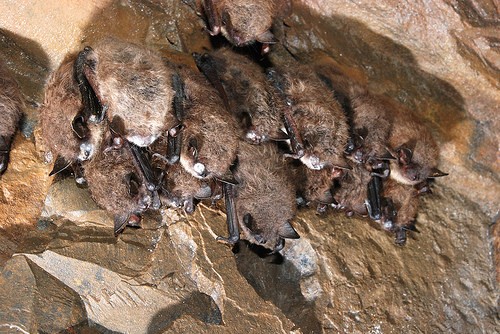Take a moment to look at the night sky and watch the swift flight of bats on their daily mission as they dart through your backyard or forest. Now, think about how it’s becoming harder to spot these winged wonders, and ask why. The answer: The quickly growing spread of a disease known as white-nose syndrome has been decimating bat populations, as explained in a recently released film on the subject.
This increasingly devastating disease has killed more than six million bats in just six years, a serious problem for a creature that provides so many benefits to the environment – as both a plant pollinator and as a major predator in keeping insect populations in check.
“White-nose syndrome is caused by a non-native fungus that has invaded North American caves and mines and is killing entire populations of hibernating bats as it spreads across the continent,” said Cathy Johnson, a Forest Service bat biologist.
Bats eat insects —a lot of insects. They consume more than half their body weight in insects each night making them the primary predators of night-flying insects, including many crop and forest pests. The loss of these industrious agricultural workers could cost up to $53 billion in increased pesticide costs and crop damages each year, according to a recent study.
The new film, “Battle for Bats: Surviving White-Nose Syndrome,” released in partnership with state and federal agencies and conservation organizations, highlights how government agencies and conservation groups are working together to combat this destructive disease. It provides an in-depth look at the current status of WNS and illustrates ways in which the public can help protect bats and provide them with healthy habitats.
“The potential for White-Nose Syndrome to spread to bat populations in the Western states and additional Canadian provinces is cause for concern,” said Monica Tomosy, the national wildlife research program leader with U.S. Forest Service Research and Development. “We are working every research angle, including soil fungal pathology, invasive fungal species control, bat ecology, monitoring design, and landscape ecology in an effort to provide managers with mechanisms to slow the spread of the disease.”
WNS has spread very quickly since it was first discovered in a cave in New York in 2006. As of March 2014, bats with WNS have been found in more than 22 states and five Canadian provinces as the disease continues to spread in all directions across the landscape.
“There are lots of opportunities for the public to learn more about bats and become involved in the fight to save them,” Johnson said. “Bats have never needed our help more than now.”
The following tips offer ways you can join the effort and make a difference to help save our bats and keep them as an important part of the night sky.
- Volunteer! You can help protect bats on public lands by helping with bat counts, acoustical monitoring and much more. Contact your local national forest for more information.
- Adhere to cave closures. If caves are open, follow all decontamination protocols recommended by the U.S. Fish and Wildlife Service to clean clothes, footwear and equipment used in caves and mines.
- Stay out of caves when bats are present.
- Build and install a bat house to provide a safe place for bats on your property.
- Teach your friends and family about the benefits of bats. Visit BatsLIVE: A Distance Learning Adventure to learn how to make bats come alive in your home or classroom.
- Join us for the showing of the film, “Battle for Bats: Surviving White-Nose Syndrome,” at the 2014 Environmental Film Festival in the Nation’s Capitol on March 27, 2014 at 7 p.m. to learn more.
- Take time to see live bats by visiting public bat viewing sites.


